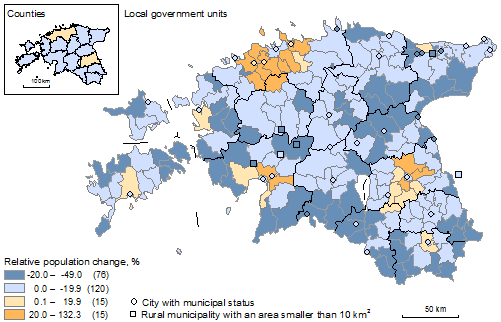PHC 2011: the population of Estonia is concentrated around larger cities
Compared to the previous census of 2000, the population of Estonia has decreased by 75,597 persons, i.e. by 5.5%. The population has grown only in Harju and Tartu counties.
“Among local government units, population increase has been the biggest in the rural municipalities around Tallinn city – in some of these municipalities, the number of inhabitants has doubled compared to the previous census,” said Ms Diana Beltadze, Project Manager of the 2011 Population and Housing Census.
For example, the population has increased to 18,533 in Viimsi rural municipality (7,978 in 2000), to 15,721 in Rae rural municipality (7,979 in 2000), and to 14,181 in Harku rural municipality (6,617 in 2000).
There has also been a significant increase in population in some rural municipalities around Tartu city (from 4,780 to 7,751 in Ülenurme rural municipality and from 5,121 to 6,991 in Tartu rural municipality) and around Pärnu city (from 2,535 to 4,474 in Sauga rural).
Map 1. Relative population change in local government units, 2000–2011

Estonian cities are shrinking
There are only three cities in Estonia (excl. cities without municipal status) where the population has increased between the two censuses: Saue (11.2%), Maardu (4.7%) and Keila (4%). In the remaining cities, the population has decreased. Compared to 2000, the decrease in population has been the biggest in smaller cities.
| Cities | 2000 | 2011 | 2011–2000 (change) | % |
|---|---|---|---|---|
| Saue | 4,958 | 5,514 | 556 | 11.2 |
| Maardu | 16,738 | 17,524 | 786 | 4.7 |
| Keila | 9,388 | 9,763 | 375 | 4 |
| Tallinn | 400,378 | 393,222 | –7,156 | –1.8 |
| Sindi | 4,179 | 4,076 | –103 | –2.5 |
| Tartu | 101,169 | 97,600 | –3,569 | –3.5 |
| Paldiski | 4,248 | 4,085 | –163 | –3.8 |
| Elva | 6,020 | 5,607 | –413 | –6.9 |
| Rakvere | 17,097 | 15,264 | –1,833 | –10.7 |
| Põlva | 6,467 | 5,767 | –700 | –10.8 |
| Kuressaare | 14,925 | 13,166 | –1,759 | –11.8 |
| Narva-Jõesuu | 2,983 | 2,632 | –351 | –11.8 |
| Kunda | 3,899 | 3,422 | –477 | –12.2 |
| Pärnu | 45,500 | 39,728 | –5,772 | –12.7 |
| Põltsamaa | 4,849 | 4,188 | –661 | –13.6 |
| Jõgeva | 6,420 | 5,501 | –919 | –14.3 |
| Valga | 14,323 | 12,261 | –2062 | –14.4 |
| Narva | 68,680 | 58,663 | –10,017 | –14.6 |
| Paide | 9,642 | 8,228 | –1,414 | –14.7 |
| Tõrva | 3,201 | 2,729 | –472 | –14.7 |
| Võru | 14,879 | 12,667 | –2,212 | –14.9 |
| Haapsalu | 12,054 | 10,251 | –1,803 | –15 |
| Viljandi | 20,756 | 17,473 | –3,283 | –15.8 |
| Sillamäe | 17,199 | 14,252 | –2,947 | –17.1 |
| Võhma | 1,596 | 1,314 | –282 | –17.7 |
| Kärdla | 3,773 | 3,050 | –723 | –19.2 |
| Loksa | 3,494 | 2,759 | –735 | –21 |
| Kohtla-Järve | 47,679 | 37,201 | –10,478 | –22 |
| Mustvee | 1,753 | 1,358 | –395 | –22.5 |
| Kiviõli | 7,405 | 5,634 | –1,771 | –23.9 |
| Mõisaküla | 1,165 | 825 | –340 | –29.2 |
| Kallaste | 1,211 | 852 | –359 | –29.6 |
| Püssi | 1,872 | 1,083 | –789 | –42.1 |
The shares of the urban and rural population have not changed much since the 2000 census. According to 2011 data, 67.9% of the population lives in urban settlements (incl. cities, cities without municipal status and towns). In 2000, 69.2% of the population of Estonia lived in urban settlements.
Of the 4,438 villages in Estonia, 12 have more than 1,000 residents and 645 have 100–999 residents. Most of the villages (3,781) are inhabited by less than 100 persons, and 327 villages have less than three permanent residents. There were 102 villages with no permanent residents.
Several big villages have developed in areas close to cities. The villages with the biggest population are: Peetri – 4,435 (Harju county), Muraste – 1,698 (Harju county), Randvere – 1,690 (Harju county), Vahi – 1,620 (Tartu county), Alliku – 1,575 (Harju county), Tammiste – 1,562 (Pärnu county), Pärnamäe – 1,556 (Harju county), Lohkva – 1,288 (Tartu county), Püünsi – 1,256 (Harju county), and Papsaare – 1,028 (Pärnu county).
Average age has increased
Compared to the previous census, the average age of the Estonian residents has increased. The 5.5-year increase in life expectancy between 2000 and 2011 is considered the main reason for this. In 2000, the average age was 38.7 years, whereas in 2011 it was 40.8 years. The average age of men is 37.7 years (35.9 in 2000) and the average age of women is 43.4 years (41.1. in 2000).
The residents of Harju and Tartu counties are younger than the average, with their respective average ages being 36.3 and 38.1 years. The residents’ average age is the highest in Piirissaare (63.1 years) and Alajõe (53.9 years) rural municipalities.
The results of PHC 2011 regarding the age-sex distribution of the population in local government units can be found in Statistics Estonia’s database. The results of PHC 2011 will be published over the course of 2012 and 2013. The schedule of publication can be found at www.REL2011.ee.
The 11th population census in Estonia was conducted from 31 December 2011 until 31 March 2012. Previous censuses were carried out in 1881, 1897, 1922, 1934, 1941, 1959, 1970, 1979, 1989 and 2000. The next population census will be conducted in Estonia in 2020/2021.